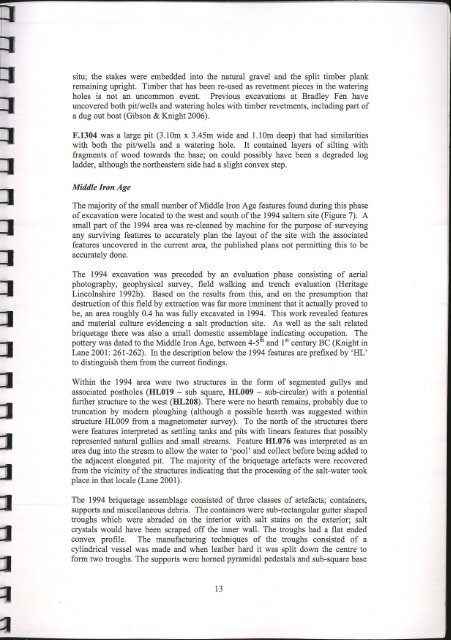Further Excavations At Langtoft. Lincolnshire www - Archaeology ...
Further Excavations At Langtoft. Lincolnshire www - Archaeology ...
Further Excavations At Langtoft. Lincolnshire www - Archaeology ...
Create successful ePaper yourself
Turn your PDF publications into a flip-book with our unique Google optimized e-Paper software.
situ; the stakes were embedded into the natural gravel and the split timber plank<br />
remaining upright. Timber that has been re-used as revetment pieces in the watering<br />
holes is not an uncommon event. Previous excavations at Bradley Fen have<br />
uncovered both pit/wells and watering holes with timber revetments, including part of<br />
a dug out boat (Gibson & Knight 2006).<br />
F.1304 was a large pit (3.10m x 3.45m wide and 1.10m deep) that had similarities<br />
with both the pit/wells and a watering hole. It contained layers of silting with<br />
fragments of wood towards the base; on could possibly have been a degraded log<br />
ladder, although the northeastern side had a slight convex step.<br />
Middle Iron Age<br />
The majority of the small number of Middle Iron Age features found during this phase<br />
of excavation were located to the west and south of the 1994 saltern site (Figure 7). A<br />
small part of the 1994 area was re-cleaned by machine for the purpose of surveying<br />
any surviving features to accurately plan the layout of the site with the associated<br />
features uncovered in the current area, the published plans not permitting this to be<br />
accurately done.<br />
The 1994 excavation was preceded by an evaluation phase consisting of aerial<br />
photography, geophysical survey, field walking and trench evaluation (Heritage<br />
<strong>Lincolnshire</strong> 1992b). Based on the results from this, and on the presumption that<br />
destruction of this field by extraction was far more imminent that it actually proved to<br />
be, an area roughly 0.4 ha was fully excavated in 1994. This work revealed features<br />
and material culture evidencing a salt production site. As well as the salt related<br />
briquetage there was also a small domestic assemblage indicating occupation. The<br />
pottery was dated to the Middle Iron Age, between 4-5 1 and 1 st century BC (Knight in<br />
Lane 2001: 261-262). In the description below the 1994 features are prefixed by 'HL'<br />
to distinguish them from the current findings.<br />
Within the 1994 area were two structures in the form of segmented gullys and<br />
associated postholes (HL019 - sub square, HL009 - sub-circular) with a potential<br />
further structure to the west (HL208). There were no hearth remains, probably due to<br />
truncation by modern ploughing (although a possible hearth was suggested within<br />
structure HL009 from a magnetometer survey). To the north of the structures there<br />
were features interpreted as settling tanks and pits with linears features that possibly<br />
represented natural gullies and small streams. Feature HL076 was interpreted as an<br />
area dug into the stream to allow the water to 'pool' and collect before being added to<br />
the adjacent elongated pit. The majority of the briquetage artefacts were recovered<br />
from the vicinity of the structures indicating that the processing of the salt-water took<br />
place in that locale (Lane 2001).<br />
The 1994 briquetage assemblage consisted of three classes of artefacts; containers,<br />
supports and miscellaneous debris. The containers were sub-rectangular gutter shaped<br />
troughs which were abraded on the interior with salt stains on the exterior; salt<br />
crystals would have been scraped off the inner wall. The troughs had a flat ended<br />
convex profile. The manufacturing techniques of the troughs consisted of a<br />
cylindrical vessel was made and when leather hard it was split down the centre to<br />
form two troughs. The supports were horned pyramidal pedestals and sub-square base<br />
13

















